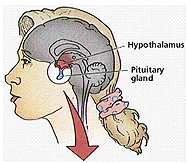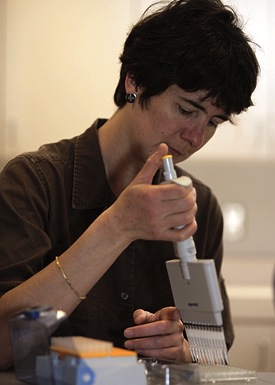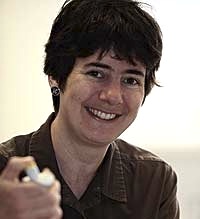There’s no easy way to explain what happened to mathematician Mary Lou Zeeman — though it all began simply enough.
Nine years ago, Bowdoin’s new professor was chatting with a gynecologist who mentioned his questions about in vitrofertilization (IVF) treatment protocols, which included administration of a cycle of birth control pills to suppress ovarian function, followed by daily injections of hormones to induce maturation of follicles and eggs in the ovaries.
He wanted to better understand the results of these therapies — based on factors including a woman’s age, hormonal level, and ovarian functioning — to more accurately predict the outcome of treatment, tailor the treatment to individual patients, and reduce stressors and outright dangers that might interfere with pregnancy in some women.
Knowing that Zeeman was a mathematician, he asked her to look at his data on women who had received birth control pills and those who hadn’t to try to see if she could find some statistical basis for treatment results.
Just “for fun,” she says, she conscripted some of her undergraduates at the University of Texas at San Antonio where she taught from 1991-2006. Together, they analyzed daily data on changes in the women’s estrogen levels and follicle growth, and turned up patterns in the data that intrigued the gynecologist.
“I asked him: ‘Why are you surprised? How does the menstrual cycle usually work?’ ” recalls Zeeman. “There’s always a mechanism that causes the statistical pattern. I figured that I could just find the mathematical model for the normal menstrual cycle, and because I am a mathematician, I would be able to adjust it slightly to correspond to all these extra hormones that correspond to the treatment for IVF, and see what it predicts.”

It’s one thing to develop new mathematical equations describing biological processes. It’s quite another to be performing scientific assays to see if your equations have real biologic underpinngs. Mary Lou Zeeman does it all. Find out how in this illustrated primer.
After researching the literature in both mathematical and crossover math-biology journals, Zeeman learned something that truly astonished her: There was no mathematical model for the menstrual cycle.
“I was stunned,” says Zeeman, her eyes gleaming. “When I say nothing, I mean that after I searched and searched and searched, I found that over the last 30 years there were less than a dozen papers looking at the menstrual cycle from the mathematical point of view.
“The feminist part of me was horrified that there was no work on this incredibly important subject. The mathematical part of me was thrilled: You mean the subject is wide open?!”
Zeeman quickly got to work. She steeped herself in biology, sitting in on college classes on everything from Bio 101 to genetics to neurobiology. Eventually, her quest brought to her to visit the University of Michigan and earned her a grant from the National Science Foundation for cross-disciplinary research in biology at Cornell University, where she met up with her primary research partner biologist David McCobb.
“I discovered a drive in myself I didn’t know I had,” says Zeeman. “Some colleagues told me I was destroying my career. But I didn’t have a choice: I knew this was what I wanted to do.”
With her expertise in geometrical dynamical systems — a mathematical tool for studying how things change, or cycle — Zeeman began pioneering collaborative working with McCobb to begin answering some of the basic, outstanding questions about how the menstrual cycle works.
 The crux of the mathematical challenge is to gather and plot data about the hormonal interaction of the hypothalamus, pituitary and ovaries, the biological axis of the menstrual cycle — consider them variables. If mathematical models can be developed that accurately mimic pituitary functioning under normal circumstances, simulating the appropriate parameter changes in the same model can then be used for understanding interruptions in this complex cycling for women with a variety of infertility problems.
The crux of the mathematical challenge is to gather and plot data about the hormonal interaction of the hypothalamus, pituitary and ovaries, the biological axis of the menstrual cycle — consider them variables. If mathematical models can be developed that accurately mimic pituitary functioning under normal circumstances, simulating the appropriate parameter changes in the same model can then be used for understanding interruptions in this complex cycling for women with a variety of infertility problems.
Their ongoing work in mathematical neuroendocrinolgy, or “biomathematics,” will now be part of the academic landscape at Bowdoin. Starting January 1, 2007, Zeeman will be a tenured member of the faculty and will develop a laboratory at the College for both the biological research and the computational analysis.
“This work is really accessible to undergraduates,” says Zeeman. “Because the field is so new, there are plenty of experiments to do that translate between the biology and the math. I am hoping to interest both biology and math majors and get them working together.
“I need undergraduates who enjoy designing equipment, those who enjoy running assays in the lab, people who are interested in going out and collecting data and talking to other scientists and clinicians. And then there is all the mathematical analysis of the equations. There is beautiful work for the math majors to do and computer simulation for students who are computer savvy.”
In the Fall, Zeeman taught courses in differential calculus and biomathematics at the College. During the spring semester, she will return to Cornell to advance her work with McCobb, before returning to campus this summer to set up her lab. She will continue to alternate a semester of teaching and research at Bowdoin with a semester of research at Cornell, and hopes to be able to create advanced research channels connecting students at both institutions.
“If we could really fire up one or two students who love the subject, it would be a great experience for them. We would love to help students progress through this work from one of the best undergraduate institutions to one of the best graduate institutions in the country.
“The atmosphere at Bowdoin is so positive and the students are generous characters in every way. They are not just smart kids. They are really interested in learning and they genuinely care about the common good as well. And, and William DeWitt Hyde said in his “Offer of the College,” the point of education is not to make the lives easier for those who happen to be able to get educated, it is to train them to use the talent they were given for the common good.”
